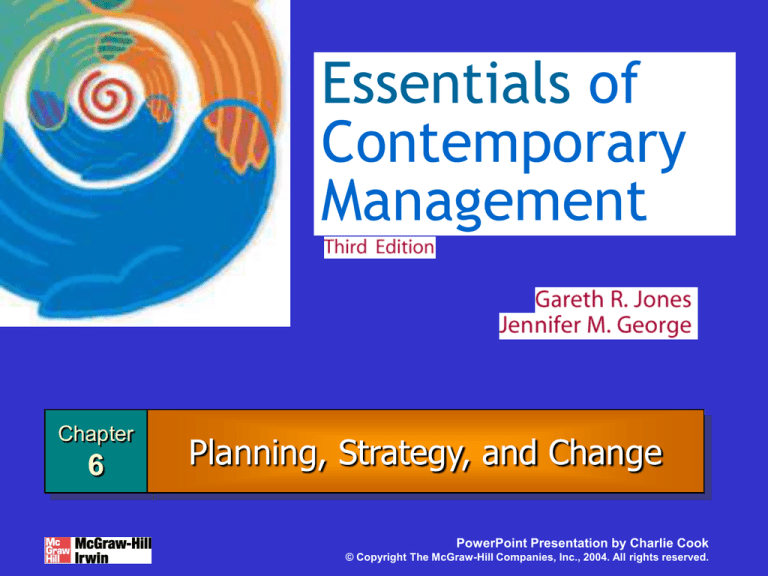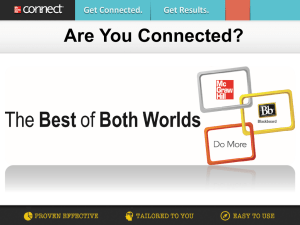
Essentials of
Contemporary
Management
Chapter
6
Planning, Strategy, and Change
PowerPoint Presentation by Charlie Cook
© Copyright The McGraw-Hill Companies, Inc., 2004. All rights reserved.
Learning Objectives
• After studying the chapter, you should be able to:
Describe the three steps of the planning process.
Explain the relationship between planning, strategy,
and change.
Explain the role of planning in predicting the future
and in changing the organization so it can meet future
challenges.
Outline the main steps in SWOT analysis.
Differentiate among corporate-, business-,
functional-level strategies.
© Copyright 2004 McGraw-Hill. All rights reserved.
6–2
Learning Objectives (cont’d)
Describe the vital role played by strategy
implementation in determining managers’ ability
to achieve an organization’s mission and goals.
© Copyright 2004 McGraw-Hill. All rights reserved.
6–3
The Planning Process
• Planning
Identifying and selecting appropriate goals (goal
making) and courses of action (strategy-making)
for an organization.
• The organizational plan that results from the planning
process details the goals and specifies how
managers will attain those goals.
• Strategy
The cluster of decisions and actions that
managers take to help an organization reach its
goals.
© Copyright 2004 McGraw-Hill. All rights reserved.
6–4
Three Steps in Planning
Figure 6.1
© Copyright 2004 McGraw-Hill. All rights reserved.
6–5
The Planning Process
• Mission
A broad declaration of an organization’s purpose
that identifies the organization’s products and
customers and distinguishes the organization from
its competitors.
© Copyright 2004 McGraw-Hill. All rights reserved.
6–6
Planning Process Stages
• Determining the Organization’s Mission and
Goals
Defining the organization’s overriding purpose and
its goals.
• Formulating strategy
Managers analyze current situation and develop the
strategies needed to achieve the mission.
• Implementing strategy
Managers must decide how to allocate resources
between groups to ensure the strategy is achieved.
© Copyright 2004 McGraw-Hill. All rights reserved.
6–7
Levels and Types of Planning
Figure 6.2
© Copyright 2004 McGraw-Hill. All rights reserved.
6–8
Levels of Planning at General Electric
Figure 6.3
© Copyright 2004 McGraw-Hill. All rights reserved.
6–9
Levels of Planning
• Corporate-Level Plan
Top management’s decisions pertaining to the
organization’s mission, overall strategy, and
structure.
Provides a framework for all other planning.
• Corporate-Level Strategy
A plan that indicates in which industries and
national markets an organization intends to
compete.
© Copyright 2004 McGraw-Hill. All rights reserved.
6–10
Levels of Planning
• Business-Level Plan:
Divisional managers’ decisions pertaining to
division’s long-term goals, overall strategy, and
structure.
• Identifies how the business will meet corporate goals.
• Business-Level Strategy
A plan that indicates how a division intends to
compete against its rivals in an industry.
• Shows how the business will compete in market.
© Copyright 2004 McGraw-Hill. All rights reserved.
6–11
Levels of Planning
• Functional-Level Plan
Functional managers’ decisions pertaining to the
goals that they propose to pursue to help the
division attain its business-level goals.
• Functional Strategy
A plan that indicates how a functional department
intends to achieve its goals.
© Copyright 2004 McGraw-Hill. All rights reserved.
6–12
Who Plans?
• Corporate-Level Plans
Plans developed by top management who also are
responsible for approving business- and functionallevel plans for consistency with the corporate plan.
Top managers should seek input on corporate level
issues from all management levels.
• Business-Level Plans
Plans developed by divisional managers who also
review functional plans.
• Both management levels should also seek
information from other levels.
© Copyright 2004 McGraw-Hill. All rights reserved.
6–13
Time Horizons of Plans
• Time Horizon
The intended duration of a plan.
• Long-term plans are usually 5 years or more.
• Intermediate-term plans are 1 to 5 years.
• Short-term plans are less than 1 year.
Corporate and business-level goals and strategies
require long- and intermediate-term plans.
Functional plans focus on short-to intermediateterm plans.
Most organizations have a rolling planning cycle
to amend plans constantly.
© Copyright 2004 McGraw-Hill. All rights reserved.
6–14
Types of Plans
• Standing Plans
Used in programmed decision situations.
• Policies are general guides to action.
• Rules are formal written specific guides to action.
• Standard operating procedures (SOP) specify an
exact series of actions to follow.
• Single-Use Plans
Developed for a one-time, nonprogrammed issue.
• Programs: integrated plans achieving specific goals.
• Project: specific action plans to complete programs.
© Copyright 2004 McGraw-Hill. All rights reserved.
6–15
Why Planning Is Important
• Planning ascertains where the organization is
now and deciding where it will be in the future.
Participation: all managers are involved in setting
future goals.
Sense of direction and purpose: planning sets goals
and strategies for all managers.
Coordination: plans provide all parts of the firm
with understanding about how their systems fit with
the whole.
Control: Plans specify who is responsible for the
accomplishment of a particular goal.
© Copyright 2004 McGraw-Hill. All rights reserved.
6–16
Qualities of Effective Plans (Fayol)
• Unity
Only one central plan is in effect at any given time.
• Continuity
Planning is an ongoing broad-framework process
involving all managerial levels.
• Accuracy
Managers have incorporated all available
information into creating the current plan.
• Flexibility
Managers alter the plan as the situation changes.
© Copyright 2004 McGraw-Hill. All rights reserved.
6–17
Determining the Organization’s
Mission and Goals
• Defining the Business
Who are our customers?
What customer needs are being satisfied?
How are we satisfying customer needs?
• Establishing Major Goals
Provides the organization with a sense of direction.
Stretches the organization to higher levels of
performance.
Goals must be challenging but realistic with a
definite period in which they are to be achieved.
© Copyright 2004 McGraw-Hill. All rights reserved.
6–18
Peter Drucker’s Fundamental Questions
• What is our business?
Who is the customer?
What is of value to the customer?
• What will our business be?
• What should our business be?
© Copyright 2004 McGraw-Hill. All rights reserved.
6–19
Four Mission Statements
Figure 6.4
© Copyright 2004 McGraw-Hill. All rights reserved.
6–20
Product-oriented vs. Market-oriented Definitions
of Business
• Xerox--making a copying equipment vs. helping improve
office productivity
• Columbia Pictures—making movies vs. marketing
entertainment
• Carrier—making air conditioners vs. providing climate control
in the home
• Pioneer—producing Audio equipments vs. facilitating
customer singing
• Shiseito—manufacturing cosmetics vs. selling hope
• Fuji film—selling camera film vs. storing memory
• Star TV—providing satellite connection vs. producing
entertainment
© Copyright 2004 McGraw-Hill. All rights reserved.
6–21
Good Mission Statements
Limited number of goals
--Concentration
Stress major policies & values
-- as stretch guidelines
Define competitive scopes
--by customers groups, customer needs,or
technology
© Copyright 2004 McGraw-Hill. All rights reserved.
6–22
Formulating Strategy
• Strategic Formulation
Managers analyze the current situation to develop
strategies for achieving the mission.
• SWOT Analysis
A planning exercise in which managers identify
organizational/internal strengths and weaknesses,
• Strengths (e.g., superior marketing skills)
• Weaknesses (e.g., outdated production facilities)
and external opportunities and threats.
• Opportunities (e.g., entry into new related markets).
• Threats (increased competition).
© Copyright 2004 McGraw-Hill. All rights reserved.
6–23
Planning and Strategy Formulation
Figure 6.5
© Copyright 2004 McGraw-Hill. All rights reserved.
6–24
Formulating Corporate-Level Strategies
• Concentration in Single Business
Can become a strong competitor, but can be risky.
• Knowledge of current market can be a competitive
advantage. (core business logics/core competence)
• Concentration creates a large degree of business risk
if the single market in which the firm competes
declines.
Concentration is a logical strategy if downsizing
organization to increase performance by exiting
under-performing businesses.
© Copyright 2004 McGraw-Hill. All rights reserved.
6–25
Formulating Corporate-Level Strategies
• Diversification
Related diversification into similar market areas to
build upon existing competencies.
• Synergy: two divisions working together perform
better than the sum of their individual performances
(2+2=5).
Unrelated diversification is entry into industries
unrelated to current business.
• Attempts to build a portfolio of unrelated firms to
reduce risk of single industry failure.
• Unrelated firms can be more difficult to manage.
© Copyright 2004 McGraw-Hill. All rights reserved.
6–26
International Expansion
• Basic Question:
To what extent do we customize products and
marketing for different national conditions?
• Global strategy
Selling the same standardized product and using
the same basic marketing approach in all countries.
• Standardization provides for lower production cost.
• Ignores national differences that local competitors
can address to their advantage.
© Copyright 2004 McGraw-Hill. All rights reserved.
6–27
International Expansion (cont’d)
• Mulitdomestic Strategy
Customizing products and marketing strategies to
specific national conditions.
• Helps gain market entry and build local market share.
• Raises production costs.
© Copyright 2004 McGraw-Hill. All rights reserved.
6–28
Vertical Integration
• Vertical Integration
A strategy that allows an organization to create
value by producing its own inputs or distributing its
own products.
• Backward vertical integration occurs when a firm
seeks to reduce its input costs by producing its own
inputs.
• Forward vertical integration occurs when a firm
distributes its outputs or products to lower distribution
costs and ensure the quality service to customers.
A fully integrated firm faces the risk of bearing the
full costs of an industry-wide slowdown.
© Copyright 2004 McGraw-Hill. All rights reserved.
6–29
Stages in a Vertical Value Chain
© Copyright 2004 McGraw-Hill. All rights reserved.
6–30
Porter’s Business-Level Strategies
Number of Market Segments Served
Strategy
Many
Low-cost
Focused low-cost
Differentiation
Focused differentiation
Few
Table 6.2
© Copyright 2004 McGraw-Hill. All rights reserved.
6–31
Formulating Business-Level Strategies
• Low-Cost Strategy
Driving the organization’s total costs down below
the total costs of rivals.
• Manufacturing at lower costs, reducing waste.
• Lower costs than competition means that the low cost
producer can sell for less and still be profitable.
• Differentiation
Offering products different from those of
competitors.
• Differentiation must be valued by the customer in
order for a producer to charge more for a product.
© Copyright 2004 McGraw-Hill. All rights reserved.
6–32
Formulating Business-Level Strategies
• Focused Low-Cost
Serving only one market segment and being the
lowest-cost organization serving that segment.
• Focused Differentiation
Serving only one market segment as the most
differentiated organization serving that segment.
© Copyright 2004 McGraw-Hill. All rights reserved.
6–33
Functional-level Strategies
• A plan that indicates how an organizational
function intends to achieve its goals.
Seeks to have each department add value to a
good or service.
Marketing, service, and production functions can all
add value to a good or service through:
• Lowering the costs of providing the value in products.
• Adding new value to the product by differentiating.
Functional strategies must fit with business level
strategies.
© Copyright 2004 McGraw-Hill. All rights reserved.
6–34
Goals for Successful Functional Strategies
1. Attain superior efficiency as a measure of
outputs for a given unit of input.
2. Attain superior quality by producing reliable
products that do their intended job.
3. Attain superior innovation developing new
and novel features that can be added to the
product or process.
4. Attain superior responsiveness to
customers by acknowledging their needs and
fulfilling them.
© Copyright 2004 McGraw-Hill. All rights reserved.
6–35
Planning and Implementing Strategy
1. Allocate implementation responsibility to the
appropriate individuals or groups.
(delegation)
2. Draft detailed action plans for
implementation.
3. Establish a timetable for implementation.
4. Allocate appropriate resources.
5. Hold specific groups or individuals
responsible for the attainment of corporate,
divisional, and functional goals.
(accountability)
© Copyright 2004 McGraw-Hill. All rights reserved.
6–36
Program Formulation--The McKinsey 7-S
Framework
Structure
Strategy
Systems
Shared
values
Skills
Style
Staff
© Copyright 2004 McGraw-Hill. All rights reserved.
6–37
Homework 5 Decide the Boundary of firm
• Publishers of even the smallest daily
newspapers usually own their own presses,
but even the largest book publishers normally
contract their printing jobs to independent
printers.
• What accounts for this difference in who owns
the printing process?
© Copyright 2004 McGraw-Hill. All rights reserved.
6–38






